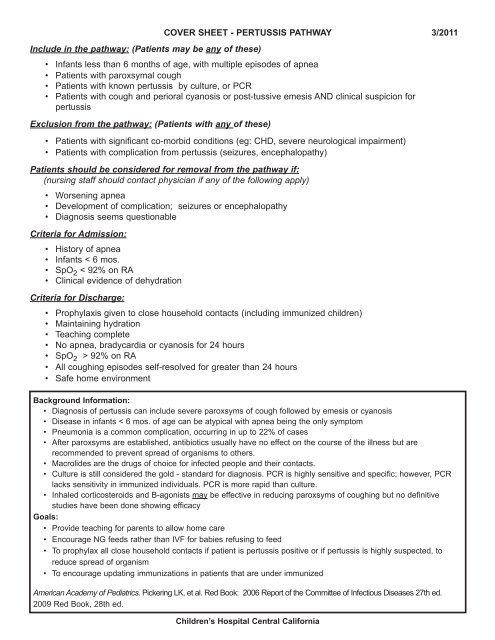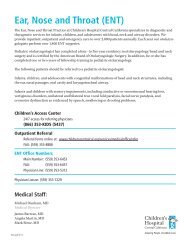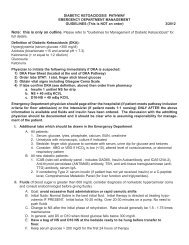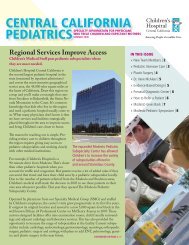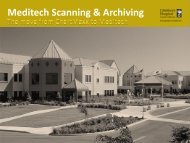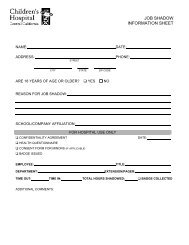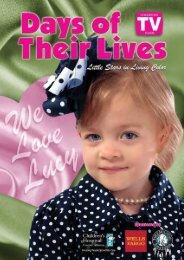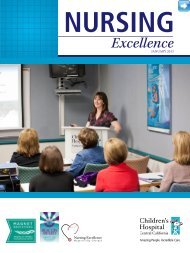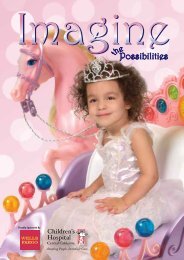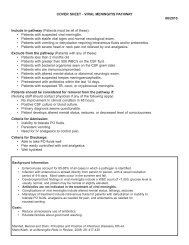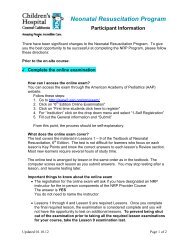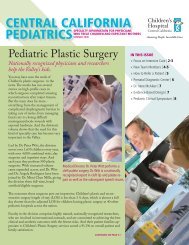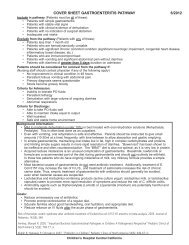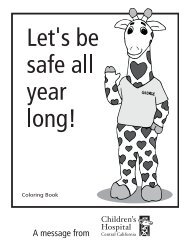Pertussis Pathway - Children's Hospital Central California
Pertussis Pathway - Children's Hospital Central California
Pertussis Pathway - Children's Hospital Central California
- No tags were found...
Create successful ePaper yourself
Turn your PDF publications into a flip-book with our unique Google optimized e-Paper software.
Include in the pathway: (Patients may be any of these)COVER SHEET - PERTUSSIS PATHWAY 3/2011• Infants less than 6 months of age, with multiple episodes of apnea• Patients with paroxsymal cough• Patients with known pertussis by culture, or PCR• Patients with cough and perioral cyanosis or post-tussive emesis AND clinical suspicion forpertussisExclusion from the pathway: (Patients with any of these)• Patients with significant co-morbid conditions (eg: CHD, severe neurological impairment)• Patients with complication from pertussis (seizures, encephalopathy)Patients should be considered for removal from the pathway if:(nursing staff should contact physician if any of the following apply)• Worsening apnea• Development of complication; seizures or encephalopathy• Diagnosis seems questionableCriteria for Admission:• History of apnea• Infants < 6 mos.• SpO 2 < 92% on RA• Clinical evidence of dehydrationCriteria for Discharge:• Prophylaxis given to close household contacts (including immunized children)• Maintaining hydration• Teaching complete• No apnea, bradycardia or cyanosis for 24 hours• SpO 2 > 92% on RA• All coughing episodes self-resolved for greater than 24 hours• Safe home environmentBackground Information:• Diagnosis of pertussis can include severe paroxsyms of cough followed by emesis or cyanosis• Disease in infants < 6 mos. of age can be atypical with apnea being the only symptom• Pneumonia is a common complication, occurring in up to 22% of cases• After paroxsyms are established, antibiotics usually have no effect on the course of the illness but arerecommended to prevent spread of organisms to others.• Macrolides are the drugs of choice for infected people and their contacts.• Culture is still considered the gold - standard for diagnosis. PCR is highly sensitive and specific; however, PCRlacks sensitivity in immunized individuals. PCR is more rapid than culture.• Inhaled corticosteroids and B-agonists may be effective in reducing paroxsyms of coughing but no definitivestudies have been done showing efficacyGoals:• Provide teaching for parents to allow home care• Encourage NG feeds rather than IVF for babies refusing to feed• To prophylax all close household contacts if patient is pertussis positive or if pertussis is highly suspected, toreduce spread of organism• To encourage updating immunizations in patients that are under immunizedAmerican Academy of Pediatrics. Pickering LK, et al. Red Book: 2006 Report of the Committee of Infectious Diseases 27th ed.2009 Red Book, 28th ed.Children’s <strong>Hospital</strong> <strong>Central</strong> <strong>California</strong>
Time/Date:GeneralWeight:Allergies:1) Dx: <strong>Pertussis</strong>2) Estimated length of stay = 6 days3) Condition: Stable4) Respiratory Droplet isolation5) CR monitor < 6 mos. of age6) Vitals and pain assessment: every 6 hours and as needed for pain7) BP on admission and routine8) Activity: as tolerated9) Initiate “Learning Assessment” and implement pertussis education10) On admit, assess discharge needs and make appropriate referrals (see pediatric admission database).Education1) Begin education on admission2) Teach signs of worsening respiratory distress and signs of dehydration3) Review "Patient education sheet" with family4) If patient demonstrated apnea during course of illness, schedule CPR training for family5) If patient is using albuterol or inhaled steroid, do MDI teaching6) Encourage care provider to update patient's immunization status after dischargeDiet and Fluids1) Diet: Age appropriate; hold feeds for severe retractions or consistent respiratory rate > 70.2) I's and O's3) Do not start I.V. unless patient requires I.V. fluids. If already in place, saline lock PIV and do not restart if I.V.infiltrates.Criteria for supplemental feedings or I.V. fluids:• Oral intake consistently inadequate (< 75% of maintenance for > 24 hours; *see below for definition ofmaintenance)• Severe retractions or consistent respiratory rate > 70• DehydrationNG feeds are preferred for inadequate intake or mild dehydration. I.V. fluids are preferred for respiratory distress.Nurse may initiate NG feedings or I.V. fluids based on the above guidelines and using clinical judgement.• For NG feeding, place NG tube and initiate feedings using age-appropriate formula at 15ml/kg every 3 hours.Obtain nutrition consult and adjust feedings per nutrition recommendations. Discontinue NG tube when able toresume feedings.• If I.V. fluids are required, place I.V. and begin maintenance I.V. fluids (see below). When able to resume feedings,saline lock and do not restart if I.V. infiltrates. (Nurse to call pharmacy if I.V. fluids needed)Physician’s Signature/ID Number: ____________________________________ Date: ____/____/____ Time: _________________<strong>Pertussis</strong>page 1Patient Label0032pathway 3/2011Physician’s Order Sheet
Time/Date:Definition of maintenance Fluids:1-10 kg 4mL/kg/hr11-20 kg 40mL/hr + (2mL/kg/hr for each kg> 10)>20 kg 60mL/hr + (1mL/kg/hr for each kg> 20)Choice of I.V. Fluids:for children < 15 kg, use D5 ¼ NS; add 20 mEq KCI/Lfor children > 15 kg, use D5 ½ NS; add 20 mEq KCI/LOxygen and Monitoring1) O 2 to keep sats > 92%2) CR monitor, O 2 sat monitor3) Bag and mask set-up for blow-by oxygen.MedicationsWeight:Allergies:• Azithromycin 10 mg/kg PO once daily for 5 days OPTIONAL: Albuterol MDI 2 puffs every 4 hrs PRN for wheezing (check if wanted) OPTIONAL: Fluticasone 44 mcg/puff MDI 2 puffs BID (check if wanted)• Acetaminophen 15 mg/kg (max. dose = 650 mg) PO/PR every 4 hours PRN T > 38.4º C or mild pain(max. dose = 75 mg/kg/day or 4 gms/day, whichever is less)Nursing• Suction with bulb syringe, nasal aspirator or catheter and saline PRN for airway obstruction (only use catheter withsignificant respiratory compromise)Diagnostic Tests• <strong>Pertussis</strong> PCR• CBC with auto diff (if not done in ER) Echo and EKG (Recommended for all infants < 3 months of age or white blood cell > 30,000 or sustainedheart rate > 200 per minute) Respiratory DFAFollow-up1) Bedside nurse to acquire list of all direct household contacts, with their body weight and medication allergies, forprophylaxis, print and complete antibiotic prophylaxis sheet as indicated.2) Fax discharge instructions and Medication Reconciliation Form to primary care physicianPhysician’s Signature/ID Number: ____________________________________ Date: ____/____/____ Time: _________________<strong>Pertussis</strong> page 2Patient Label0032pathway 3/2011Physician’s Order Sheet
❏ ❏ ❏ ❏ ❏ ❏ ❏ ❏ ❏ ❏ ❏ ❏ ❏ ❏ ❏ ❏ ❏ ❏ ❏ ❏ ❏ ❏ ❏ ❏ ❏ ❏ ❏ ❏ ❏ ❏ ❏ ❏ ❏ ❏ ❏ ❏ ❏ ❏ ❏ ❏ ❏ ❏ ❏ ❏ ❏ ❏ ❏ ❏ ❏ ❏ ❏ *0006*
Ongoing Interdisciplinary Patient/Family Education Documentation FormAssessment Key ↓<strong>Pertussis</strong>Knowledge of Plan of Care or Plan of Treatment1. Comprehensive, 2. Good, 3. Limited, 4. None, 5. 0ther (explain in comments)Readiness to learn: 1. Asking pertinent questions, 2. Actively listening, 3. Unreceptive, 4. No interest demonstrated, 5. DistractedBarriers to learning: 1. No barriers, 2. Low literacy or education level present as a barrier, 3. Cultural, 4. Language, 5. Visual,hearing, speaking, 6. Religious/spiritual, 7. Cognitive, 8. Emotional, 9. Motivation, 10. Pain or fatigue, 11. Other (identify below)Accommodations for barriers or methods for teaching: 1. No accommodations needed, 2. Interpreter utilized, 3. Audio VisualAids used, 4. Handouts in specific language (specify type of handout) 5. Explanation given, 6. Demonstration given, 7. Referred to classor session, 8. OtherLearning Outcomes: 1. Indicates understanding or performs successfully, 2. Needs reinforcement, 3. Refuses teaching, 4. Unable tocomplete teaching (describe in comments), 5. Unable to learn materials/concepts or give return demonstration, 6. No learner available,7. Not an issue (not applicable)Remember: An initiallearning assessmentmust be completed oneach learner.AssessedLearning NeedsImmunizationsMedications (MDIadministration if appropriate)Signs of inadequatePO intakeAnticipatory Guidance(Growth and Development)HygieneGive family <strong>Pertussis</strong>Education Sheet(reinforceeducation on signs ofworsening respiratorydistress)DateTimeLearnerPlan of Care or TxReadiness to learnBarriersAccommodationsLearningOutcomesLicenseCommentsInitialsDate________ Signature____________________ Initial________Date________ Signature____________________ Initial________Date________ Signature____________________ Initial________Ongoing entries are dated, timed, and initialed for each entry.Date, sign, and place your initial at the bottom of each page.Date________ Signature____________________ Initial________Date________ Signature____________________ Initial________Date________ Signature____________________ Initial________*0006*pathway 5/2003Patient/Family Education Documentation Form
<strong>Pertussis</strong>Education Information for Patients and FamiliesWhat is pertussis?<strong>Pertussis</strong> (whooping cough) is an infection in the airways of the lungs that causes the breathingtubes (airways) to swell and narrow, leading to irritation and cough.How did my child get pertussis?It is caused by a bacteria called Bordetella pertussis. <strong>Pertussis</strong> is easily spread from one person toanother person. The infection may seem like a bad cold. People get it by breathing in air dropletsreleased from the nose or throat of a person who has the infection when he coughs, sneezes ortalks. It is also spread by contact with drainage from the nose or throat of a person who has theinfection.How will I know if my child has pertussis?The first signs are like that of a cold (runny nose, cough, sneezing, mild fever). Usually, over the2 weeks after you notice some first signs, the cough becomes worse. The cough comes in spasmsand can be followed by a high-pitched ‘whoop’ sound when taking in a breath. The whoop isfrom breathing through the narrow airways. Often children under 2 years of age do not whoop.The coughing spells are worse at night and can last for 1 to 2 months. The coughing can makeyour child• Vomit• Turn blue (face, lips or nails)• Have difficulty eating or drinkingWho gets pertussis?Anyone can get pertussis. Infants, children, or adults that have not been vaccinated or notvaccinated completely are at risk. Infants under the age of one are most at risk. <strong>Pertussis</strong> is mostdangerous to infants less than 1 year old. Older children and adults can get it even if they havebeen vaccinated as a child because protection from the vaccine only lasts 5 to 10 years from themost recent shot.How can I prevent the spread of pertussis?• Finish immunizations.• WASH YOUR HANDS frequently throughout the day• If your child has pertussis, he/she can infect others up until 5 full days afterantibiotics have been completed.• It is best to keep your child away from others who are sick. (kissing can spreadrespiratory germs)• Keep your baby or child from coughing or sneezing on others• Do not share drinks or food.• Clean drinking and eating utensils well after useChildren’s <strong>Hospital</strong> <strong>Central</strong> <strong>California</strong> • 9300 Valley Children’s Place • Madera CA 93636 • (559) 353-3000Revised: 10/2008 Review by: 08/2011 Page 1 of 3
<strong>Pertussis</strong>Education Information for Patients and FamiliesWhat is the treatment for pertussis?The treatment for pertussis may include:• Antibiotics• Breathing treatments• Oxygen therapy• Medicines for a feverWhat can I do at home?• Keep your child calm, explain what’s happening. If you need further help on how todo this, talk with your nurse. Your nurse can also refer you to others who can help,for example, Child Life specialists, play therapists, etc.• Encourage your child to drink plenty of fluids and get lots of rest. Warm apple juiceis comforting and can help break the coughing spasms.• Use cool mist humidifiers• Raise the head of the bed if possible, so your child is not lying flat. This may make iteasier for him/her to breathe. DO NOT use pillows for infants.• Hold infants upright for feedings and place on side after feedings.• Give small frequent feedings.• Burp frequently.• NO SMOKING: Tobacco smoke makes coughing worse. Children who haverespiratory infections are more likely to have trouble breathing if they are aroundtobacco smoke. Do not let anyone smoke around your child or inside of your home orcar.• AVOID smells that trigger coughing like perfumes, air fresheners, candles, hairspray, smoke from fireplacesWhen should I call my child’s doctor?**If your child has:• coughing spasms that cause their face, hands, or feet to turn blue• nasal flaring (the openings of the nose open wide with breathing )• retractions (sinking of the skin between the ribs)• breathing that becomes faster• paleness to area around nose and mouth• a poor appetite, not drinking, or ability to eat or feed has worsened• difficulty waking up or is less active than usual• become very irritable or anxious, increase in complaint of pain or you are unable tocalm him or her• Fever of 100.4 degrees Fahrenheit for children two months of age or younger.• Do not give Acetominophen (Tylenol) or Ibuprofen (Pediaprofen) before calling yourdoctor.• A fever you are concerned aboutChildren’s <strong>Hospital</strong> <strong>Central</strong> <strong>California</strong> • 9300 Valley Children’s Place • Madera CA 93636 • (559) 353-3000Revised: 10/2008 Review by: 08/2011 Page 2 of 3
••<strong>Pertussis</strong>Education Information for Patients and Families**If you cannot reach your child’s doctor, and your child has any of the symptoms describedabove, take your child to the Emergency Department closest to you.Call 911, if your child:• makes a grunting noise when breathing• turns blue or gray in color• passes out• stops breathing• has a seizureStart CPR if needed.Children’s <strong>Hospital</strong> <strong>Central</strong> <strong>California</strong> • 9300 Valley Children’s Place • Madera CA 93636 • (559) 353-3000Revised: 10/2008 Review by: 08/2011 Page 3 of 3
1234567Name: ____________________________________ Relationship: ________________ DOB: _______ Wt: _____ kg.Allergies: _________________________________ Other Med/Medical conditions: _____________________________________________________________________________________________________________________________Funding source: __________________ Rx Given/Type: ___________________________ Filled: yes noPMD:______________________________________________________________Name: ____________________________________ Relationship: ________________ DOB: _______ Wt: _____ kg.Allergies: _________________________________ Other Med/Medical conditions: _____________________________________________________________________________________________________________________________Funding source: __________________ Rx Given/Type: ___________________________ Filled: yes noPMD:______________________________________________________________Name: ____________________________________ Relationship: ________________ DOB: _______ Wt: _____ kg.Allergies: _________________________________ Other Med/Medical conditions: _____________________________________________________________________________________________________________________________Funding source: __________________ Rx Given/Type: ___________________________ Filled: yes noPMD:______________________________________________________________Name: ____________________________________ Relationship: ________________ DOB: _______ Wt: _____ kg.Allergies: _________________________________ Other Med/Medical conditions: _____________________________________________________________________________________________________________________________Funding source: __________________ Rx Given/Type: ___________________________ Filled: yes noPMD:______________________________________________________________Name: ____________________________________ Relationship: ________________ DOB: _______ Wt: _____ kg.Allergies: _________________________________ Other Med/Medical conditions: _____________________________________________________________________________________________________________________________Funding source: __________________ Rx Given/Type: ___________________________ Filled: yes noPMD:______________________________________________________________Name: ____________________________________ Relationship: ________________ DOB: _______ Wt: _____ kg.Allergies: _________________________________ Other Med/Medical conditions: _____________________________________________________________________________________________________________________________Funding source: __________________ Rx Given/Type: ___________________________ Filled: yes noPMD:______________________________________________________________Name: ____________________________________ Relationship: ________________ DOB: _______ Wt: _____ kg.Allergies: _________________________________ Other Med/Medical conditions: _____________________________________________________________________________________________________________________________Funding source: __________________ Rx Given/Type: ___________________________ Filled: yes noPMD:______________________________________________________________Patient Label0540*0540*<strong>Pertussis</strong> <strong>Pathway</strong> 12/2002Exposure Contact List
Dictation: 1-800-411-1001 (#963)D/S Job #: ________Discharge SheetFor <strong>Hospital</strong> Use OnlyDischarge sheet FAXed to primary care physician _______________initial/dateFollow-up appointment SCHEDULED with primary care physician _______________initial/datePATIENT’S NAME:_______________________________________________________ DISCHARGE DATE:___________________Dx:1) <strong>Pertussis</strong> or <strong>Pertussis</strong> Syndrome<strong>Hospital</strong> Coursenegative• <strong>Pertussis</strong> PCR: (circle one)• <strong>Pertussis</strong> Culture (if done):positive• CXR findings (if done) ________________________________Patient admitted for paroxysmal cough, cyanosis or apneaPatient diagnosed with pertussis/pertussis syndrome. Treated per pathway orders.negativepositive(circle one)Complications during hospitalization: __________________________________________________________________________________________________________________________________________________________DISCHARGE CONDITION:_______________________________________________ Discharge weight: ________Instructions to PatientActivity: No one should smoke near the baby. Avoid all other exposure to smoke (including fireplace and barbeque); avoidcontact with other infants; limit travel.Diet: Regular diet; formula or breast feed as before, encourage oral intake.Medications:See Medication Reconciliation Form. Follow up with: _________________________________________Check outpatient prescription for AzithromycinCheck with your primary care doctor to assure your child’s immunizations are up to date.Additional instructions: Return immediately if child has difficulty breathing, stops breathing or cannot eat. Please ensurethat all close household contacts have been prescribed antibiotics to prevent spread of the disease.Signed: ______________________________________ M.D.____________________________________________Attending Physician____________________________________________Signature of Parent or Guardian_________________________________________Attending Resident________________________________________________Primary Care Physician_____________________________________________City<strong>Pertussis</strong>Patient Label0083*0083*pathway 3/2011Discharge Instructions


